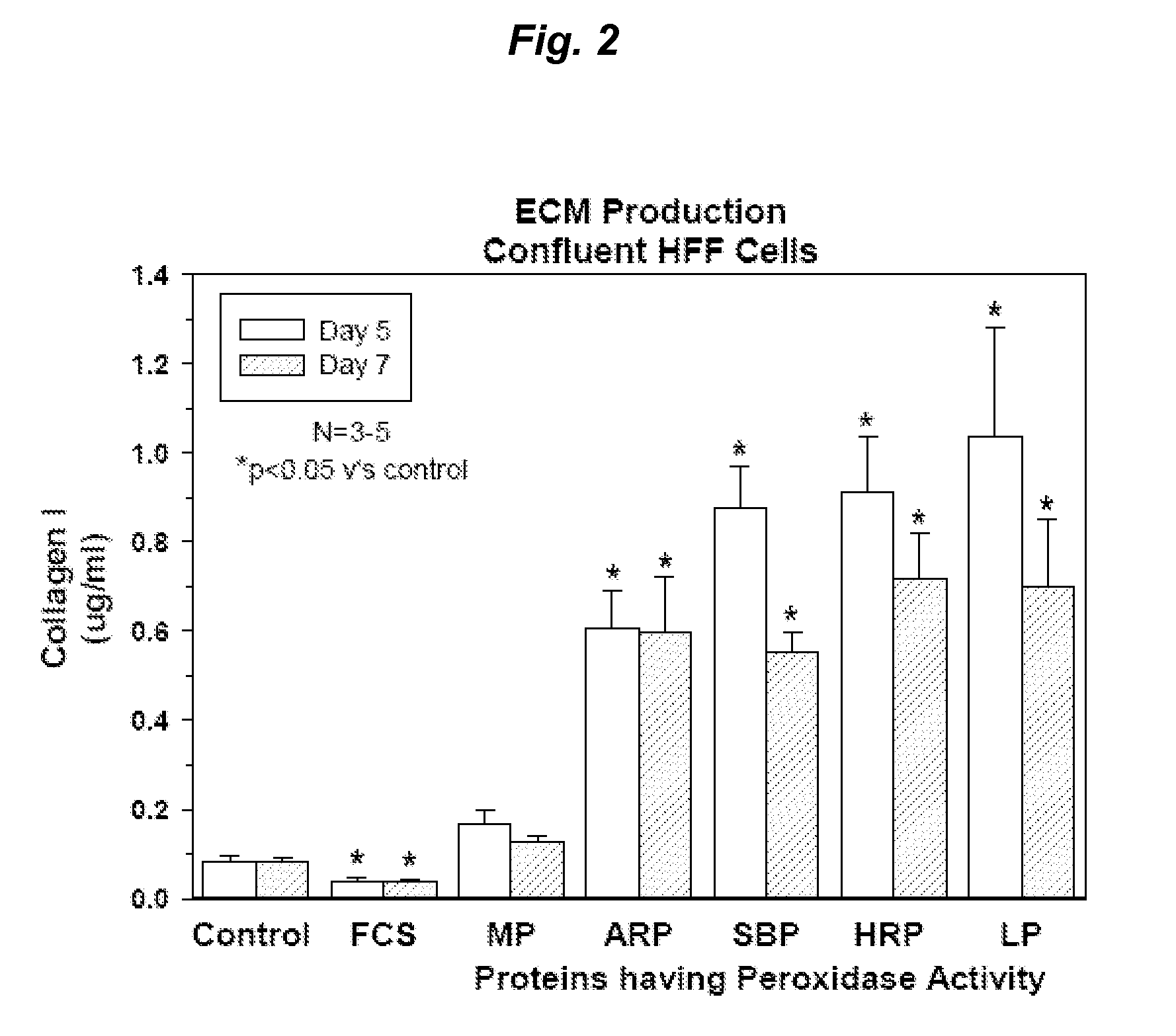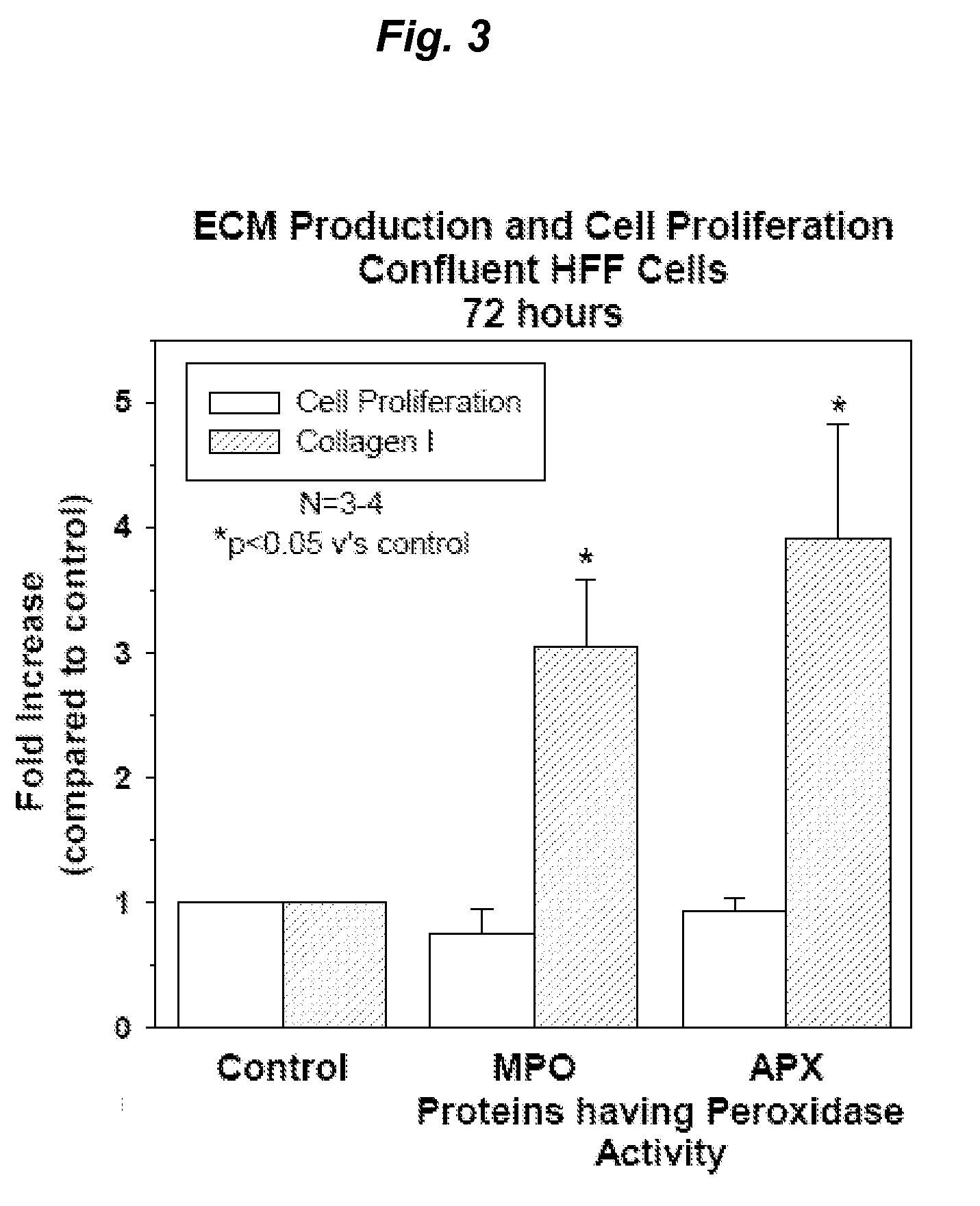Promoting ecm production by fibroblast cells and/or promoting migration of fibroblast cells in a biological system
a technology of fibroblast cells and fibroblasts, which is applied in the direction of biochemistry apparatus and processes, skeletal/connective tissue cells, enzymes, etc., can solve the problems of crow's feet, ecm loss leads to volume depletion and soft tissue contour defects, and the number of deficiencies in the treatment of ecm loss, etc., to facilitate chemotaxis of fibroblast cells and promote the movement of fibroblast cells
- Summary
- Abstract
- Description
- Claims
- Application Information
AI Technical Summary
Benefits of technology
Problems solved by technology
Method used
Image
Examples
example 1
[0402]Proteins with Peroxidase Activity Stimulate Production of an Array of ECM Proteins by Human Fibroblast Cells
[0403]Primary human foreskin fibroblast cells (HFF) were seeded into 96 well plates at a density of 1.2×104 cells / well and cultured overnight in 10% fetal bovine serum / Dulbecco's minimum essential media (10% FBS / DMEM) at 37° C. and 5% CO2. The cells were then starved overnight in serum free DMEM and triplicate wells treated for six hours with a range of doses of proteins with peroxidase activity; horse radish peroxidase (HRP; 0.2-50 ug / ml), Arthromyces ramosus peroxidase (ARP; 0.2-50 ug / ml), microperoxidase (MP; 8-500 ug / ml), soy bean peroxidase (SBP; 0.2-100 ug / ml) and lactoperoxidase (LP; 10-310 ug / ml) (all obtained from Sigma-Aldrich). At the end of the six hour treatment period, the media was aspirated and replaced with fresh serum free DMEM and the cells cultured for a further 72 hours. After 72 hours the culture media was collected for assessment of secreted, solub...
example 2
[0416]ECM Protein Production by Human Foreskin Fibroblast Cells can be Stimulated Repeatedly by Proteins with Peroxidase Activity
[0417]Experiments were performed to ensure human fibroblast cells could be stimulated to increase ECM protein production by proteins having peroxidase activity after more than one application of the proteins having peroxidase activity. The capacity to respond repeatedly to the proteins having peroxidase activity provides important utility for the generation of ECM in vitro, particularly given that spent culture media needs to be replaced on a regular basis to maintain the viability of the cells. These experiments were performed using human foreskin fibroblast cells (HFF cells) seeded into 96 well plates at a density of 1.2×104 cells / well and cultured for one week in 10% fetal bovine serum / Dulbecco's minimum essential media (10% FBS / DMEM) at 37° C. and 5% CO2 (as described in Example 3). The confluent cells were then starved overnight in serum free DMEM and...
example 3
[0419]Proteins having Peroxidase Activity Promote the Infiltration of Human Fibroblast Cells into Tissue Regeneration Scaffolds
[0420]Human dermal fibroblast cells, both autologous and heterologous, can be seeded onto a variety of three-dimensional frameworks or scaffolds made from natural ECM based proteins or biocompatible synthetic polymers, or suspended in a range of semi-solid matrices such as collagen or protein hydrogel matrices using conventional technology. For example, cells can be seeded onto a porous matrix of fibers of cross-linked bovine tendon collagen and a glycosaminoglycan such as chondroitin-6-sulphate. One such example of a dermal regeneration scaffold composed of collagen and glycosaminoglycan is INTEGRA®. Experiments were undertake to determine the effect of proteins having peroxidase activity on the ability of fibroblast cells (primary adult-derived fibroblast cells and HFF cells) to populate three-dimensional frameworks or scaffolds and semi-solid matrices and...
PUM
| Property | Measurement | Unit |
|---|---|---|
| Fraction | aaaaa | aaaaa |
| Composition | aaaaa | aaaaa |
| Biological properties | aaaaa | aaaaa |
Abstract
Description
Claims
Application Information
 Login to View More
Login to View More - R&D
- Intellectual Property
- Life Sciences
- Materials
- Tech Scout
- Unparalleled Data Quality
- Higher Quality Content
- 60% Fewer Hallucinations
Browse by: Latest US Patents, China's latest patents, Technical Efficacy Thesaurus, Application Domain, Technology Topic, Popular Technical Reports.
© 2025 PatSnap. All rights reserved.Legal|Privacy policy|Modern Slavery Act Transparency Statement|Sitemap|About US| Contact US: help@patsnap.com



